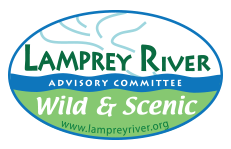THE LAMPREY RIVER CURRICULUM
A Teacher-written, Teacher-tested
Social Studies Curriculum with a Science Component for Elementary School Students by Deborah McNelly and Douglas Hoff, fourth grade teachers at Mast Way School, Lee, NH
Edited by Sharon Meeker, Extension Specialist, Sea Grant Extension and Cooperative Extension, University of New Hampshire in collaboration with the Lamprey River Advisory Committee, Lamprey River Watershed Association, The Greater Piscataqua Community Foundation, and the Barbara K. and Cyrus B. Sweet III Fund
DECEMBER, 2000
Revised and updated 2011
by Deborah McNelly and Suzanne Petersen
ACKNOWLEDGEMENTS
We want to recognize the work of our fourth grade teacher colleagues, Kris Lynes and Pam Bradley, for joining us in the activities presented in this curriculum. Their suggestions were most helpful. Mr. David Michaud, principal at Mast Way School in Lee, New Hampshire, assisted the group in every way. The Oyster River School Board also gave its support to the project. We appreciate very much the art, poetry, letters, and other classwork the fourth-grade students have contributed to make this curriculum truly a group effort.
We also recognize that this project could not have come about without the support of the Greater Piscataqua Community Foundation and the Lydia K. and Cyrus B. Sweet III Fund, offered through a grant awarded to the Lamprey River Advisory Committee. The Lamprey River Watershed Association was an important collaborator on the project, as were the University of New Hampshire's Cooperative Extension and Sea Grant programs.
We want to recognize the role Lee Selectman and Lamprey River Advisory Committee member Richard Wellington played, both in conceiving the video that inspired this curriculum, and for being an outstanding resource to the authors. Members of the local historical societies were most helpful, allowing us to peruse some of their historical materials. We particularly want to thank Phyllis Shenefiel, Richard Sanborn, and Kay Williams for their assistance in this regard. Sea Grant Communications Specialist Steve Adams assisted in the editing and printing process, and his help was very much appreciated. We also thank Margaret Watkins, National Park Service staff for the Lamprey River Advisory Committee, who shared information, maps, and other resources with the authors as they wrote the curriculum.
PREFACE
The curriculum is designed to accompany a video, River Story: The Lamprey River Through History, produced for the Lamprey River Advisory Committee by Ideaworks of Portsmouth, New Hampshire. The video focuses on the ways people have used the river for recreation and their livelihoods in the past. The curriculum aims to assist educators and their students in studying the river as a vital part of their cultural heritage. The scope of study has been broadened somewhat by including exercises that focus on the river as a habitat for plants and animals.
Each lesson could conceivably be taught as a separate entity, although we feel that studying the river as a whole is a more valuable experience. The centerpiece of the curriculum is the field trip to sites along the river. We have come to value the river as a vital part of our community through experiencing the river directly as it winds from Northwood to the shore of Great Bay. The field trip and follow-up activities, generated by the educators, parents, and other community members, make this a very important part of the curriculum.
The curriculum has two sections: the first one intended for elementary school students and the second for middle and high school students. The two sections overlap a good deal and teachers from any grade level will find looking over the lessons and resources from both sections to be useful. Each section has a table of contents and resource list that should facilitate the use of pertinent portions. The elementary portion has six lessons, or mini-units, with background for the educators preceding the activities for students. The middle and secondary school section has four mini-units and is designed primarily for the teacher, with suggested activities outlined for the students. The format encourages educators to add maps, interviews, and activities that they develop themselves to adapt the curriculum more fully to their own needs.
Finally, if any of the authors can be of assistance to educators who use this curriculum, please do not hesitate to let them know.

